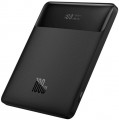Power bank charge current via USB
Nominal charge current supported by the power bank when charging its own battery via microUSB, USB type C, or Lightning (see "Battery charging inputs").
This is the maximum and, in fact, the recommended power bank charge current. If the amperes supplied by the power source exceed this value, the charge current will still be limited by the built-in controller to avoid overloading. And using a charger with a lower output current, in turn, will lead to an increase in charging time.
Data on the charge current via USB (Lightning) is especially important due to the fact that modern power banks are usually not equipped with their own chargers for these inputs, and energy sources must be separate. On the other hand, if a high charging speed is not critical for you, you can ignore this parameter: any USB connector is suitable as a power source for the corresponding power bank inputs.
Fast charge
Fast charging technologies supported by the power bank. This is primarily about charging external gadgets, but the same technology can also be used when replenishing the power bank itself.
The fast charging feature, hence the name, can significantly reduce the time spent on the procedure. This is achieved through increased current and/or voltage, as well as smart process control (at each stage, the current and voltage correspond to the optimal parameters).
Fast charging is especially important for devices with high-capacity batteries that take a long time to charge normally. However, to fully use this feature, the power source and the gadget being charged must support the same charging technology; at the same time, different technologies are not compatible with each other, although occasionally there are exceptions. The most popular fast charging formats these days are
QuickCharge (versions
3.0,
4.0 and
4.0+),
Power Delivery (
Power Delivery 3.0 and
Power Delivery 3.1),
Pump Express,
Samsung Adaptive Fast Charging,
Huawei Fast Charge Protocol,
Huawei SuperCharge Protocol..., OPPO VOOC, OnePlus Dash Charge ; Here are the specific features of these, as well as some other options:
— Quick Charge (1.0, 2.0, 3.0, 4.0, 5.0). Technology created by Qualcomm and used in gadgets with Qualcomm CPUs. The later the version, the more advanced the technology: for example, Quick Charge 2.0 has 3 fixed voltage options, and version 3.0 has a smooth adjustment in the range from 3.6 to 20 V. Most often, gadgets with a newer version of Quick Charge are also compatible with older devices for charging, but for full use, an exact match in versions is desirable.
Also note that certain versions of Quick Charge have become the basis for some other technologies. However, again, the mutual compatibility of chargers/power banks and gadgets supporting these technologies needs to be clarified separately.
— Pump Express. Own development of MediaTek, used in portable devices with CPUs of this brand. Also available in several versions, with improvements and additions as it develops.
— Power delivery. Native fast charging technology for the USB type C connector. Used by many brands, found mainly in chargers (including power banks) and gadgets using this type of connector. Presented in several versions.
— Samsung Adaptive Fast Charging. Samsung's proprietary fast charging technology. It has been used without any changes since 2015, in light of which it looks quite modest compared to newer standards. Nevertheless, it is able to provide good speed, especially in the first 50% of the charge.
— Huawei FastCharge Protocol. One of Huawei's proprietary technologies. Formally similar to Quick Charge 2.0, but used with both Qualcomm and other brands of mobile processors, so compatibility is not guaranteed. In general, it is considered obsolete, gradually being replaced by more advanced standards like the SuperCharge Protocol.
— Huawei SuperCharge Protocol. Another proprietary technology from Huawei introduced in 2016; for 2021 is available in several versions. In some devices, the power of such charging exceeds 60 V — not a record, but quite an indicator.
— Oppo VOOC. OPPO technology, used both in branded smartphones and in equipment from other brands. Available in several versions; The latest (for 2021) version of SuperVOOC is for 2-cell batteries and is sometimes listed as a separate technology called Oppo SuperVOOC Flash Charge.
— OnePlus Dash Charge. A relatively old proprietary standard from OnePlus. An interesting feature is that in some gadgets, the effectiveness of Dash Charge is practically independent of the use of the screen: when the display is on, the battery charges at almost the same rate as when it is off. Technically a licensed version of OPPO's VOOC, however, these technologies are not compatible. Since 2018, Dash Charge has been phased out by Warp Charge, but this newer technology is still rare in separately sold chargers and power banks.
— PowerIQ. Technology developed by the Anker brand. The key feature of PowerIQ is that it is not a standalone standard, but a combined format of operation that combines a wide range of popular fast charging formats. In particular, version 3.0 claims the ability to work with Quick Charge, Power Delivery, Apple Fast Charging, Samsung Adaptive Fast Charging and others. 
